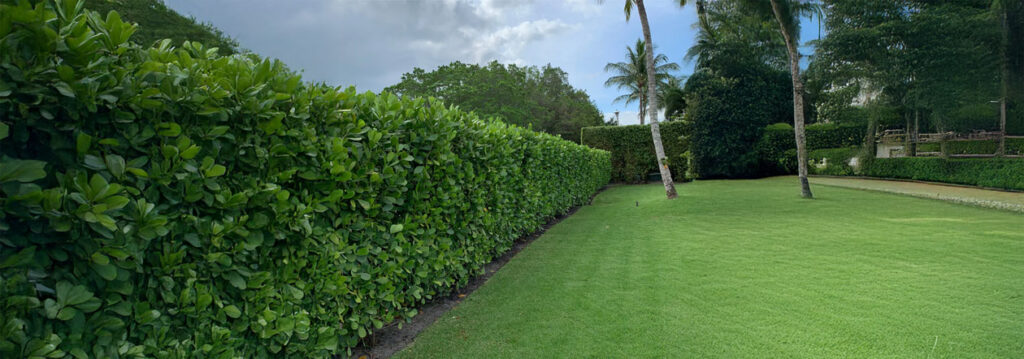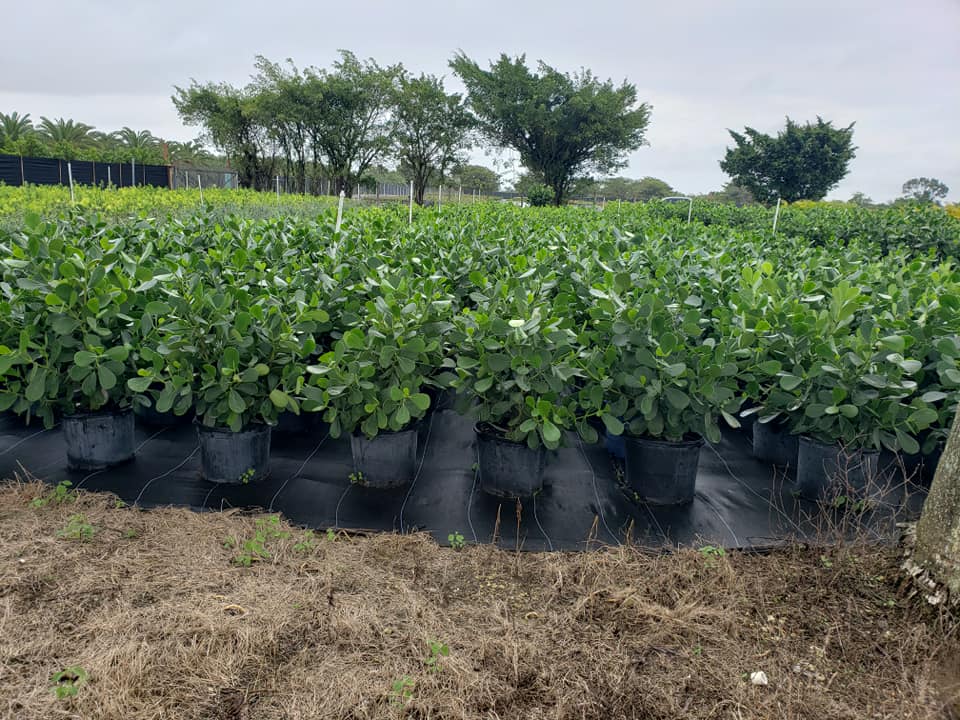Florida’s warm temperature, high humidity, and unique climate influence the plants selected for landscaping, particularly in places like West Palm Beach. Subtropical environments provide favorable conditions for many types of plants. A wise selection is not which plant may survive but which plant will be more beautifully vivacious in plant beds. Florida homeowners have the unique ability to outfit their properties with rich greenery that is well suited for high levels of humidity and warmth.

We’ve all heard it before: “No backyard is large enough to keep prying eyes away.” One of the most significant landscape features to solve privacy issues in large-plot Florida housing communities is easily the privacy hedge. In many new developments around town, lots are closely packed together to maximize profitability for the developers.
Fortunately for homeowners, a select few of these green screens accomplish the intended purpose and fit well into several landscape design schemes with good color and a prompt growing habit.
In this list of the top seven Florida privacy hedges, we will explore options that will benefit from the plant-friendly conditions offered by the climate of the Sunshine State. Multiple hedges in this list are known for their rich greens, fast-growing habit, and even frequent flowering for those southern belles!
Understanding Privacy Hedges
Privacy hedges are just what the name suggests—hedges that provide privacy. These hedges are dense plantings of shrubs or trees that act as a barrier. Homeowners plant shrubs or trees close together to create a bush wall, which gives a natural fence look to outline property.
Not only does a large privacy hedge block out unwanted views from nosy neighbors, but a good shrub or tree wall can also suck up all the sound from a busy street or quarter. Think about all of the amazing backyard dinner parties you can have in total peace and quiet. No ambient noise included.
Evergreen trees for privacy add a striking design for your home by giving you a beautiful green wall barrier. A tree line of plants is a great way to give your house a luxurious appeal. A stunning long row of green plants lining your house will create a strong contrast that will draw positive attention to the plants rather than the house that’s being blocked behind it.

Factors to Consider When Choosing Privacy Hedges in Florida
Florida is characterized by a subtropical climate that provides a home for a diverse array of plant species. We are blessed to have a very long growing season and we can see lush, green plant growth, and even flowers, just about any time of the year.
The soils in Florida may need amendments because we have such diversity. Sandy soil predominates in many areas and may need help to retain moisture and supply optimum nutrients for plant growth. Other areas have been “blessed” with a clay base and may need some “work” to provide for good drainage.
Florida-friendly hedges are those that are usually of a species native to our area, and hence well-adapted to our particular statewide “quirks”! You can plant them and forget about them, for the most part.
Top 6 Privacy Hedges for Florida
The autograph tree (Clusia rosea) is a versatile plant from the tropics. It’s an excellent plant for Florida because it serves the dual purpose of not only looking great in your yard but also acting as a visual and sound barrier—it can grow 25 feet tall. This plant has a ton of character—it’s a drought-tolerant plant thanks to the really thick leaves that kind of look like they were made out of plastic. Besides uses in landscaping as a natural privacy screen, this species can grow just fine in a variety of differently draining soils.
The yew pine (Podocarpus macrophyllus) is an evergreen tree you’ll love because it’s one of the straightforward-to-grow trees you plant and practically leave—besides trimming up the uneven parts of the greenery wall it grew you. These trees are anywhere from 10 to 30 feet tall, so not the tallest but they grow upward at an average pace of 1.63 feet per year. Other uses besides for hedges are that its foliage is dense enough to obscure it, so some people plant these just for the heck of it—the tree’s sporty aesthetically, topping people’s lists for best ornamental trees.
Leyland cypress [a hybrid between Nootka cypress (Xanthocyparis nootkatensis; formerly Cupressus nootkatensis, Chamaecyparis nootkatensis) and Monterey cypress (Hesperocyparis macrocarpa, Cupressus macrocarpa)] is a beast tree, quickly sprouting up roughly 60 feet tall; It’s not uncommon to hear of these trees being used as effective windbreaks after they’ve shut out people’s views. Other than thinning that the tree will do for you concisely, the tree’s form as you got it is easy enough to keep [with regular snipping].
Bamboo is a greenery your yard could be thick with while commercial and residential properties with them won’t have you envious over prices. You want to pick a kind in your yard, not primarily for looks because one thing is for sure—it’ll definitely cover up that mean old neighbor. Just kidding, by the way, but no one ever walked past bamboo décor and didn’t slow their walking speed just a little. Costly? Not since bamboo as viable propositional architecturals left China.
Because there are standard issues that go outside of pruning and aesthetic maintenance—like height—holly (Ilex spp.) and weeping fig (Ficus benjamina) should do anyone needing to choose something good.

Hollies are special because how they arrive in the tree market is thankfully diverse, and that’s definitely interesting. We all wish our pollen allergics away so we wouldn’t sneeze congestedly so much, but to cut down the hollies and let them grow, we know from experience.
Weeping figs are blessings because sometimes, there’s the need for a wonderfully great new amenity in an abode that just had to be taller than accommodating windows.
FAQs About Privacy Hedges in Florida
Is clusia hedge native to Florida?
Clusia is not native to Florida. The clusia hedge is “mostly” native to tropical America.
What plant makes the best hedge in Florida?
If you’re thinking about the best plants for hedges in Florida, clusia and podocarpus have to be in the running. The autograph tree, or more commonly known as clusia, has very dense foliage and can grow in a multitude of different soil types, only adding to the popularity of the plant.
Which Plants Are Best for Creating Hedges in Central Florida?
One of the most popular hedge plants in all of Florida, the yew pine is a very versatile plant that many people choose to feature in their yard, thanks to the tall (10-20 feet), lush greenery that this plant offers. And because of its “bushy” growth structure, podocarpus can be formed with little effort. Depending on what area of Central Florida that you live in, select types of plants actually make better hedges; however, you can usually count on viburnum and ligustrum along with clusia and podocarpus.
Viburnum are fantastic plants for hedges—thanks to their fast growth, lovely smell and flowers, and a few berries that local birds love. You can expect your viburnum bush to grow to approximately 10 feet tall.
How tall do clusia hedges grow?
You can expect your clusia to grow between 8-15 feet—making it a top pick when you’re planting hedges for privacy in Florida.
As a Floridian, the specific environment of this state can dictate which privacy hedges you can choose from. The relentlessly warm weather and high levels of humidity make for a different growing climate than what many other states can offer. It certainly is very good for some species and landscapes, but others may not do so well. It is better to find this out before and after getting the hedge for landscaping. Other plants for landscaping will need to be adjusted as well, so try to deliberate on soil type, salt tolerance, sun exposure, and common watering habits.
Everyone has a different yard and environment, so different plants that make a hedge need to be selected as discretely as possible. Do some research and experimentation to derive which plant would be the best for the situation. Many people sell plants as their main source of income and are around plants constantly. Some people may offer some valuable insight, so visit a few places to get some opinions if you have to.
That way, you know how to please the plant with perfect planting procedures and regular management. The ideal hedge in question (if it is being used for privacy and not another reason entirely) will complete the idealistic visual picture. This picture is something that needs landscaping and a tactful yard plan for your specific design. Many customers can recognize some places within their yard that they desire to plant a more established hedge after an in-depth and on-site tour.
